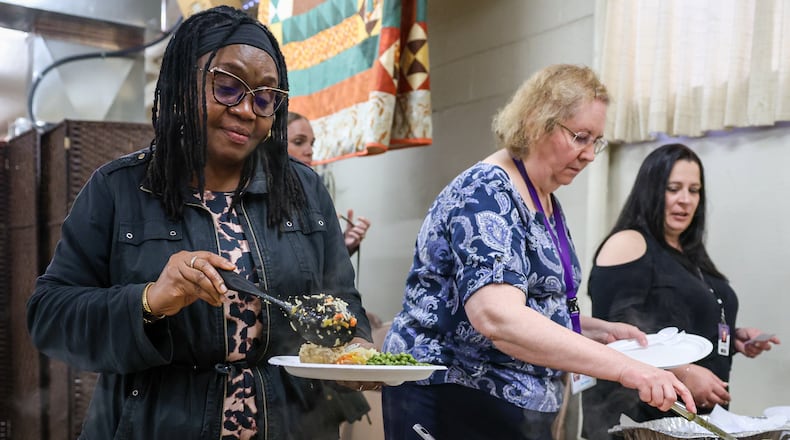The launch of the campaign came after multiple changes to immigration policy were enacted by the Trump administration this year: the proposed ends to some temporary immigration statuses, the pause of programs that assist immigrants resettling in the United States and the launch of a debate over birthright citizenship.
Leaders at Welcome Dayton, an initiative that supports the integration of immigrants in the city, say they want to change the narrative around immigrants and refugees in the Dayton region.
Dayton was certified as a “welcoming” city to immigrants in 2017, becoming the first in the nation to receive this designation from the national nonprofit Welcome America.
Local immigration experts say assisting newcomers with settling in the Dayton region and making community connections adds to the overall vibrancy of the region.
“There’s beauty in being together, learning from each other,” said Jeannette Horwitz, Welcome Dayton coordinator and an immigrant from Sweden. “The world is more colorful when we have people with different backgrounds and different ways of doing things.”
But economic development leaders say there’s more at stake — immigrants are crucial to filling labor shortages and maintaining growth throughout the state.
Credit: Ismael David Mujahid
Credit: Ismael David Mujahid
Immigration to Ohio is growing
Data helps to give perspective on the immigrant population:
• In Ohio: Although Ohio is among the top 10 most populated states in the U.S., less than 1.5% of the immigrants who reside in the nation live in Ohio.
• Growth: The Buckeye State has seen significant population growth — a 30% increase — among immigrants in the last decade.
• Analysis: Ohio’s estimated immigrant population in 2023 was more than 600,000, which makes up a little more than 5% of the state’s overall population, according to an analysis published by the American Immigration Council last year.
• Immigrants in Dayton: An estimated 8,400 immigrants are based in Dayton, according to 2023 U.S. Census Bureau data.
• Global presence: Roughly 41% of immigrants living in Montgomery County come from an Asian nation, a majority of those from India and China. Immigrants from a European nation — primarily from Russia and Germany — make up the second-biggest slice of immigrant population, according to a 2022 American Immigration Council report.
• Population breakdown: Immigrants from Central American, Caribbean, African and South American nations make up roughly 36% of Montgomery County’s migrant population.
• Immigration and Mexico: Mexico remains the top country of origin overall, representing 9.6% of the immigrant population in Montgomery County.
Local refugee population
Hundreds of immigrants were resettled in Montgomery County through a federal program that was halted in January.
The U.S. Refugee Admissions Program has brought people from other nations since Congress created it in 1980 for refugees fearing persecution because of their race, religion, nationality, membership in a social group and more.
According to the Ohio Department of Job and Family Services, a total of 456 refugees were resettled in the Dayton area last year — 411 of them from the Democratic Republic of Congo. Dayton saw more refugees from that nation than any other major Ohio city.
Cross Over Community Development, located at the Ahiska Turkish Community Center in Dayton, estimates that 40% of Dayton’s refugees are from the Democratic Republic of Congo.
The Dayton-based nonprofit has provided services like English classes, job skills training and more to immigrants and refugees from multiple nations since 2016.
These resources are foundational to immigrants making a new life in America, said Cross Over Community Development Executive Director Catherine Bitwayiki.
Refugees and other immigrants coming to Dayton are bringing specialized skills that may not be utilized due to language and cultural barriers, Bitwayiki said.
Her organization has worked with refugees who were doctors and engineers in their home countries, but they lacked the necessary certifications and connections to continue their profession when they entered the U.S.
“This is a resource we’re not using, a waste of potential,” Bitwayiki said.
Why Dayton?
Immigrants often choose where to live based on job opportunities and family connections, said Stephanie Keinath, the executive vice president of the Dayton Area Chamber of Commerce.
“At the end of the day, the Dayton region is competing with other parts of the country. We’ll never have the mountains, we’ll never have the ocean,” Keinath said. “We’ll never have a population of one million people, if you’re looking for that big city life. But they’re coming in large part because there are jobs available, and they want to fill those jobs immediately.”
Major industries that are attracting immigrant workers are healthcare, manufacturing, logistics and distribution. For Ohio at large, the agriculture industry also attracts many immigrant workers.
And the impact in southwest Ohio reverberates. In Springfield, Haitian immigrants have been credited with filling warehouse jobs and helping to revitalize what had been a struggling economy.
Although foreign-born workers made up a small percentage of the county’s overall population earlier this decade, they represented 6% of its working-age population, 5.8% of its employed labor force and 10.9% of its science, engineering, technology and math workers, according to a 2022 report from the American Immigration Council.
And there are more than enough jobs to go around, Keinath said.
“All signs in Ohio are pointing to continued growth,” she said.
Ohio’s population continues to age, with many older residents retiring and exiting the workforce. Parallel to that is a declining birth rate — the native-born workforce will simply be smaller in the decades to come, and a labor shortage already persists.
“So how do we start to move the needle? I don’t think we can get there without immigrants,” Keinath said. “It’s just not going to be possible.”
New Americans may also eye the Dayton region because of kinship networking — it’s easier to feel at home when you have a part of home nearby, Keinath said.
But immigrants also stay in Dayton to pursue education opportunities or because they married a Daytonian, Horwitz said.
Integration challenges, rewards
Employers have told Dayton Area Chamber of Commerce leadership that when hiring a foreign-born worker, barriers like communication and cultural norms in the workplace can exist, Keinath said.
The American Immigration Council estimated that roughly 20.5% of the immigrant population had limited English language proficiency. Among these households, the top languages were Spanish and Chinese.
An inability to communicate can also impact how a community operates, Horwitz said.
Welcome Dayton has been working with city departments to create pamphlets in other languages to educate residents who are comfortable in any language on topics like household safety, rules for parking and more.
Adapting to a new way of everyday life has its challenges, Horwitz said. Her department once received complaints from residents of a Dayton neighborhood regarding an immigrant resident who liked to dry their laundry outside — not on clotheslines or a drying rack, but on their fences.
“That’s what we see a lot of: cultural differences, misunderstandings,” Horwitz said. “For us to get along and work well with each other, we have to understand each other. There’s a little bit of give and take.”
This spring, Bitwayiki’s organization began hosting free community dinners with cultural dishes on the menu. These ranged from Turkish pilov, which includes rice with chicken, carrots and garbanzo beans, to Indian saag, a creamy spinach dish.
Guests who gathered during a community meal at a Hart Street church in May could also quench their thirst with Zobo, a sweet Nigerian punch made with hibiscus flower and fruit, and finish off the afternoon with an Ecuadorian dessert of strawberries and cream.
Bitwayiki said the dinners are designed to give the community a taste of the favorite dishes of immigrants — and a slice of what life in another country could resemble.
“We want everyone to grab a plate, feel welcome, meet new people,” Bitwayiki said.
Credit: Bryant Billing
Credit: Bryant Billing
About the Author





